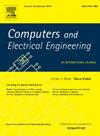受视觉皮层启发的边缘神经形态硬件架构,具有片上多层 STDP 学习功能
IF 4
3区 计算机科学
Q1 COMPUTER SCIENCE, HARDWARE & ARCHITECTURE
引用次数: 0
摘要
人工智能物联网(AIoT)时代在严格的处理延迟、成本和能耗预算下给边缘视觉处理系统带来了巨大挑战。近年来,计算高效的生物尖峰神经网络(SNN)和事件驱动神经形态架构的出现,促进了计算模式的转变,以应对这些挑战。在本文中,我们受人类视觉皮层层次结构的启发,为多层卷积 SNN(代号为 HMAX SNN 模型)提出了一种神经形态处理器架构。这项工作的主要贡献包括1) 它提出了一种完全事件驱动、模块化、可配置和可扩展的神经形态架构,允许在多层卷积 SNN 的实施成本、处理速度和视觉识别准确性之间灵活权衡。2) 它提出了一种运行时可重新配置的学习引擎,能以时间多路复用的方式,对特征提取卷积层进行快速的片上无监督尖峰计时可塑性(STDP)学习,并对特征分类 FC 层进行有监督 STDP 学习。在现有的边缘神经形态系统中,这些技术以合理的计算和内存成本,首次将修改后的美国国家标准与技术研究院(National Institute of Standards and Technology)数据库(MNIST)图像的片上学习准确率大大提高到 97% 以上。我们在低成本的 Zedboard Zynq-7020 现场可编程门阵列(FPGA)设备上搭建了硬件处理器架构原型,并在 MNIST、Fashion-MNIST、Olivetti 研究实验室(ORL)人脸和 ETH-80 图像数据集上进行了验证。实验结果表明,所提出的神经形态架构能以相对较少的硬件资源消耗实现相当高的片上学习精度、高推理吞吐量和高能效。我们预计,HMAX SNN 处理器有可能在更多实际边缘应用中加强边缘神经形态处理器的部署。本文章由计算机程序翻译,如有差异,请以英文原文为准。
A visual cortex-inspired edge neuromorphic hardware architecture with on-chip multi-layer STDP learning
The era of artificial intelligence of things (AIoT) brings huge challenges on edge visual processing systems under strict processing latency, cost and energy budgets. The emergence of computationally efficient biological spiking neural networks (SNN) and event-driven neuromorphic architecture in recent years have fostered a computing paradigm shift to address these challenges. In this paper, we propose a neuromorphic processor architecture for a multi-layer convolutional SNN (codenamed HMAX SNN model) inspired by human visual cortex hierarchy. The main contributions of this work include: 1) It proposes a fully event-driven, modular, configurable and scalable neuromorphic architecture allowing for flexible tradeoffs among implementation cost, processing speed and visual recognition accuracy with multi-layer convolutional SNNs. 2) It proposes a run-time reconfigurable learning engine enabling fast on-chip unsupervised spike-timing dependent plasticity (STDP) learning for the feature-extraction convolutional layers and also supervised STDP learning for the feature-classification FC layer, in a time-multiplexing way. These techniques greatly improve on-chip learning accuracies beyond 97 % on the Modified National Institute of Standards and Technology database (MNIST) images for the first time among existing edge neuromorphic systems, at reasonable computational and memory costs. Our hardware processor architecture was prototyped on a low-cost Zedboard Zynq-7020 Field-Programmable Gate Array (FPGA) device, and validated on the MNIST, Fashion-MNIST, Olivetti Research Laboratory (ORL) human faces and ETH-80 image datasets. The experimental results demonstrate that the proposed neuromorphic architecture can achieve comparably high on-chip learning accuracy, high inference throughput and high energy efficiency using relatively fewer hardware resource consumptions. We anticipate that the HMAX SNN processor can potentially enhance deployments of edge neuromorphic processors in more practical edge applications.
求助全文
通过发布文献求助,成功后即可免费获取论文全文。
去求助
来源期刊

Computers & Electrical Engineering
工程技术-工程:电子与电气
CiteScore
9.20
自引率
7.00%
发文量
661
审稿时长
47 days
期刊介绍:
The impact of computers has nowhere been more revolutionary than in electrical engineering. The design, analysis, and operation of electrical and electronic systems are now dominated by computers, a transformation that has been motivated by the natural ease of interface between computers and electrical systems, and the promise of spectacular improvements in speed and efficiency.
Published since 1973, Computers & Electrical Engineering provides rapid publication of topical research into the integration of computer technology and computational techniques with electrical and electronic systems. The journal publishes papers featuring novel implementations of computers and computational techniques in areas like signal and image processing, high-performance computing, parallel processing, and communications. Special attention will be paid to papers describing innovative architectures, algorithms, and software tools.
 求助内容:
求助内容: 应助结果提醒方式:
应助结果提醒方式:


